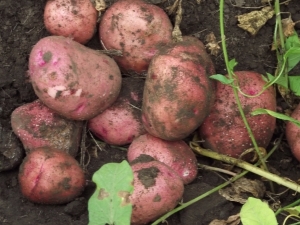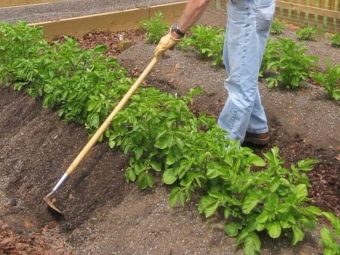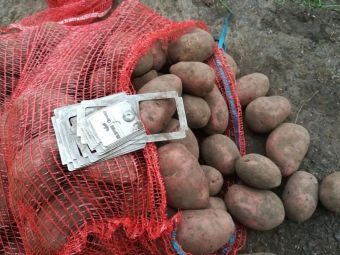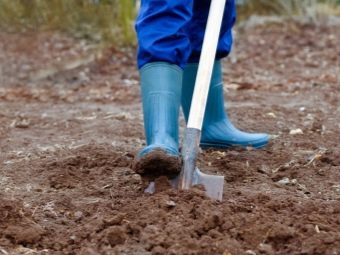Potato "Zhuravinka": description of the variety and characteristics of cultivation

Potatoes are often called “second bread”, which is true.This is the place of honor that this product occupies on the tables of Russians and residents of many other countries. Therefore, a large number of varieties of ordinary potatoes does not cause surprise. Belarus has a special attitude to it, and Belarusian vegetables are not inferior in quality to Dutch and other foreign varieties.
Potato "Zhuravinka" - one of the varieties bred by Belarusian scientists with the participation of Russian vegetable growers.
Characteristic
Potato "Zhuravinka" in the State Register is brought more than 10 years ago and still does not lose its popularity. The variety is quite unpretentious, zoned for 3 large regions of Russia: Central, Volga-Vyatka, North-West, but successfully grown almost throughout the country.
Of course, the appearance of the tops is unlikely to greatly affect the choice of variety. But the idea of what the above-ground part of the plant looks like is useful to have at least one more time to make sure that exactly the variety that was chosen grows on the site.
So, the stems of “Zhuravinki”, and there are usually up to 6 of them in a bush, can reach a height of 50–55 cm with a thickness of about 0.8 cm, which is an average for potatoes. Compact erect bush, deflected shoots except in very windy weather. Such resistance of the plant creates a certain comfort during care, namely, when hilling. The rounded, deep-green, wavy leaves at the edges have a pronounced venation of a darker shade.
Flowers "Zhuravinki" red-purple, this color in other varieties of potatoes is rare. Green berries with seeds are almost not formed. If the grown potato bush looks like it is described in this description, you can be sure that it is Zhuravinka.
Productivity is an important indicator, especially if potatoes are grown on a commercial scale. In Zhuravinki, up to 18–20 tubers can be harvested from each nest. There are cases that collected 25, but here it is necessary to note the impact on these numbers of fertility and soil structure, care and weather conditions. Collection per hectare can reach 500-600 centners.
The taste and quality of fruits are almost always decisive factors when choosing a variety for planting. According to these indicators, Zhuravinka is able to meet the requirements of any vegetable grower. The following characteristics can be noted:
- the potatoes in the bush do not vary greatly in size;
- round or oval shape;
- the color of the peel is pink-red with a more or less distinct mesh pattern;
- the flesh is yellowish with a creamy tinge;
- small eyes, located on the entire surface of the tuber;
- average weight is 90–150 g, the maximum weight is 300 g.
The use of this variety is the most diverse. Due to the high starch content (15–20%), “Zhuravinka” is used for the industrial production of this component, which is necessary in cooking. Because of this starchiness, the potatoes are quite boiled softly, but not enough to suit only mashed potatoes. It is also quite good in fried and stewed form, and it is quite possible to make chips from this potato.
And the sweetish taste of Zhuravinki celebrated by many will make any dish of it suitable even for gourmets.
Advantages and disadvantages
In addition to high yields, with a stable, and great taste, at a grade it is possible to note a number of advantages:
- unpretentiousness to growing conditions;
- marketability 85–97% (the number of potatoes suitable for use, when harvesting);
- durability up to 96% (only 4% of tubers sent for storage deteriorate);
- transportability;
- resistance to diseases (golden nematode, potato cancer, scab, black leg, late blight of tubers).
There are some disadvantages:
- late ripening (90–110 days from planting);
- the variety is unstable to rhizoctoniosis and late blight of the stems and leaves;
- sensitivity to drying out of the soil.
Note that not everyone considers harvesting in the fall to be such a big minus, especially if you plant several varieties with different ripening terms, you can have fresh potatoes on your table from July and practically until the beginning of October.
To combat diseases, there are methods that can reduce or completely eliminate the second drawback. And the third problem is easily solved by timely watering.
Landing
Growing the Zhuravinka variety is generally not different from other types of potato agrotechnics, but some features need to be taken into account.
Soil preparation
"Zhuravinka" grows well on any type of soil. The exception will be only very dense and very acidic soil, as the tubers take a long time to mature and they may start to rot. If you do not have to choose, the problem can be solved by liming and adding sand to the soil. Of course, soils with a loose structure will be preferable.
Crop rotation cannot be ignored. After the solanaceae, to which the potato itself belongs, it should not be planted, since the causative agents of diseases common to them can be found in the soil. The second year at the same place planting potatoes is also not recommended for the same reason, it is advisable not to plant it here and the third.
Organic fertilizer (manure) is better to make when autumn digging. This should not be done in the spring before planting, since there will be too much nitrogen in the soil, which is undesirable for Zhuravinki.
Preparation of planting material
Approximately two weeks before planting, the tubers left for further cultivation should be carried in boxes to a bright room. The material must be carefully selected in order to discard potatoes that have rotted, diseased and parasitized. Then, the remaining quality "seeds" are subjected to the process of vernalization (gardening) to strengthen the immunity to diseases. With the same purpose, as well as to stimulate the development of future plants, immediately before planting, the tubers can be treated with "Zircon", holding them literally for several minutes in solution.
Landing in the ground
Planting is recommended when the soil at a depth of about 10 cm warms to + 7-10 ° C. Such an indicator in different regions will be achieved at different times, respectively, and the landing time will differ:
- for the southern regions - mid-April;
- for middle latitudes - the second half of May.
Planting "Zhuravinka" should be fairly free, given that it forms a spreading root system. To prevent adjacent “nests” from touching, the tubers should be placed in the ground at an interval of 25-30 cm, and between rows it will not be superfluous and a distance of 70-75 cm. The depth of planting depends on the density of the soil, about 11 cm are planted in loose soil. , in heavier loams - by 6 cm.
Overfeeding with nitrogen "Zhuravinka" is not good, but other fertilizers within the normal range can be applied. For example, when planting under each tuber, you can pour a glass of ash.
Another important factor is the size of seed potatoes. Usually, tubers of medium size are left for planting. Since the main part of the food future bushes get it from the mother potato, even large tubers cut into more than two parts is not recommended. If only reproduction of the variety is planned with a limited amount of planting material, you can cut it smaller, but make sure that there are at least one or two eyes on the resulting parts. In this case, it is not necessary to wait for the commodity characteristics of the crop, the grown potatoes will be small, but there will be plenty of them for growing next year.
In regions with a cool climate and unstable weather conditions, plant this crop better in ridges, which warm up better.
Care
Hilling is the most important agrotechnical technique for potatoes. It must be carried out for all varieties without exception.The meaning of the process is to loosen and tamp the soil to the plants in order to create conditions for the growth of roots and the formation of tubers in the upper, more heated soil layer.
The first hilling is sometimes carried out almost immediately after the emergence of sprouts, when return frost occurs. It makes sense to fall asleep shoots completely, they later germinate again.
In heavy soils, the roots of potatoes often go deep into it, because of this, the plant does not have enough strength to form tubers and they can vary greatly in size, and there will be few potatoes in the “nest”. Hilling is recommended on such soils up to 5-6 times during the summer period. For potatoes growing in light soil, 2-3 times for the whole season will be enough. Spud better in wet weather or after watering.
Zhuravinka is sensitive to drought; therefore, with insufficient precipitation, it is important to water the potatoes in a timely manner, but make sure that no moisture stagnation occurs. This will just provide hilling or loosening. And then it will be good to add mineral dressing and mulch the soil. But if the weather is very hot, it is better to do without mulch, so as not to overheat the tubers.
For a tuberous crop, a “under-stake” fertilizer method is suitable: the nutrient solution is poured into a small hole in the ground, made around each plant by a spade handle. Foliar feeding is also possible. Plants are sprayed in the early morning or in the evening so that the sun's rays do not burn the stems and leaves.
Diseases and pests
For most diseases, the Zhuravinka potato is resistant, but may be affected by late blight of the aerial part and rhizoctoniosis.
As they say, prevention is the best treatment. Some measures are taken already during the planting of tubers: respect for crop rotation, processing of planting material, sparse planting for airing the bushes. You can also treat the ground with a solution of the drug "Fitosporin-M", applying it strictly according to the instructions. Grown up plants can be periodically sprayed with potassium permanganate solution (2 g of substance per liter of water), following the same precautions as with foliar dressings. Spraying with garlic infusion gives a good result: grind one clove, add 2 liters of water and leave for 20 minutes.
At the first signs of damage by microorganisms, it is necessary to reduce watering, since excess moisture contributes to the further development of diseases. You can apply the popular recipe: mix 0.5 liters of milk and a tablespoon of honey. Spray the potatoes with this compound. If such gentle methods are ineffective, use chemical agents with copper in the composition, Bordeaux mixture.
The most famous pest of solanaceous crops is the Colorado potato beetle. If the landing area is not very large, the most effective method would be to manually collect and destroy adult individuals and larvae. At the same time, the leaves should be carefully examined, as eggs are usually laid on their underside. Harvesting should be carried out several times per season. Detergent can serve as an onion peel, which is laid out in the aisle. You can also use the ashes, scattering the earth and the plants themselves.
To fight with Medvedka, manure traps are used, spreading its small clumps all over the field. When found on traps pests destroy them.
Harvesting and storage
The “Zhuravinka” potato ripens quite late, and it is usually harvested in the middle lane in September. The easiest way to determine the start time of the collection is by undermining a bush and looking at the tubers. If the majority of potatoes in the “nest” have reached the required size, and their skin is quite dense, it is time to harvest.
According to reviews of vegetable growers, the variety is resistant to mechanical damage, so the “Zhuravinka” can be removed both manually and by any mechanized method. After digging, the tubers should be dried in the air and sorted for being eaten or sold and for seed.Potatoes of different categories are best kept separately.
This grade does not require special storage conditions. As with any vegetables, it should be provided with a cool non-freezing room. Several times during the winter, the crop needs to be sorted out in order to remove spoiled tubers. Due to excellent keeping quality, almost all potatoes are stored until spring.
Reviews about the variety "Zhuravinka" mostly favorable. Vegetable growers talk about stable good yield, safety and good taste of potatoes. Some of the noted deficiencies: sensitivity to drought, instability to some diseases - can be avoided by applying simple recommendations. And to the question whether it is worth growing a variety on your own plot, you can definitely answer what it costs.
For more on the features of the Zhuravinka potato, see the following video.















































